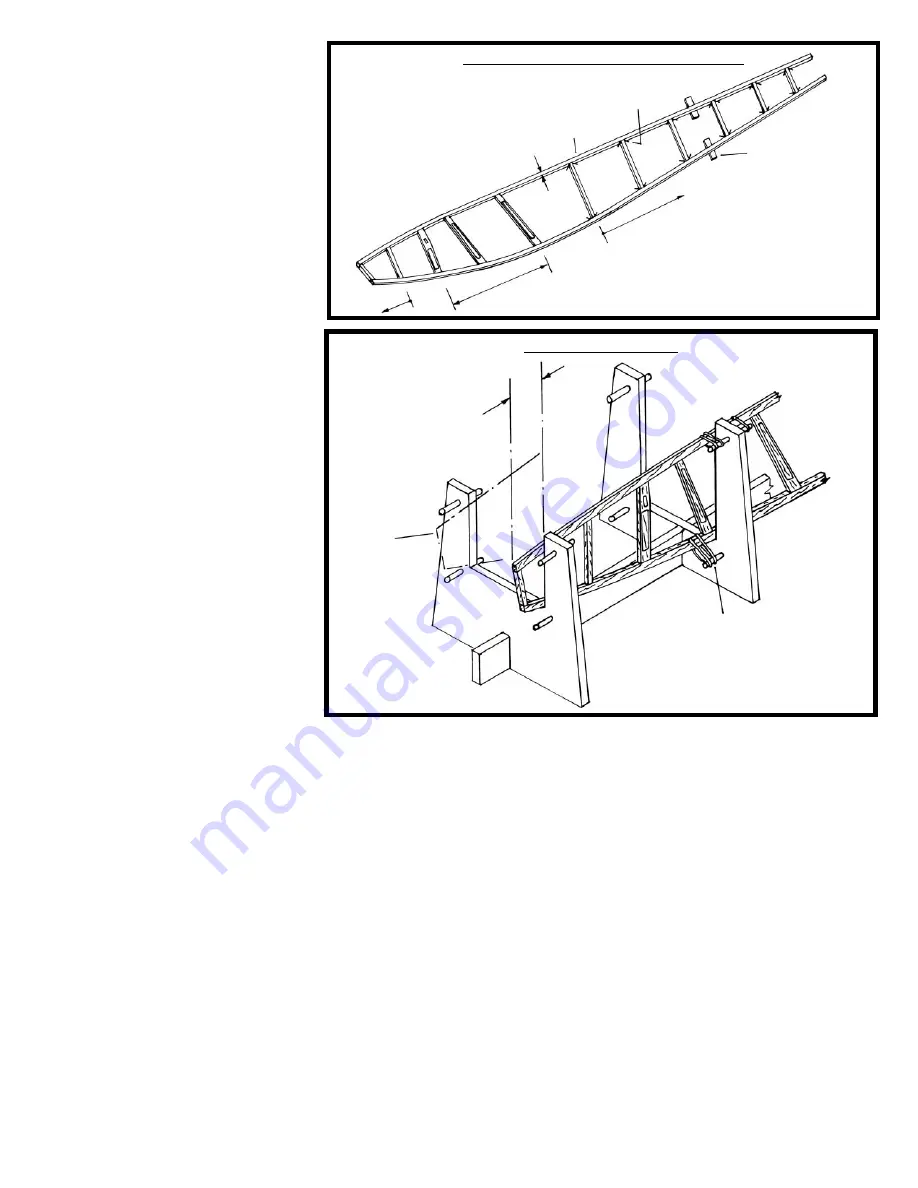
FIG. 3-5 SIDES IN JIG
1/2"
RIGHT
SIDE
RUBBER BANDS
AT EACH FORMER
17
(F27 through F32) and glue. These dowels
are used for rubber banding the fuselage
sides to the formers.
Fit each former in the slots in the center
piece. Check with a square to see if they are
perpendicular to the center piece and board.
Then glue them in place. Super glue will
work just fine here.
Figure 3-1
illustrates the
jig. Set the jig aside for now.
2. Building the Sides of the Fuselage
On the plan, starting at the nose, the side
vertical struts (and corresponding top and
bottom horizontal struts) are labeled Station
1 through 11. I will refer to these Stations in
the discussion.
The sides are to be built directly on the plan,
and both are identical. Build one side then the
other using the bottom plan on Sheet 3. This
view just shows the longerons, vertical struts,
and brace wire fittings that must be installed
along with the vertical struts. To avoid gluing
any parts to the plan, use some shims under
the longerons. Place these just to the side of
the vertical strut locations. Pin the 1/16" x
3/32" longerons over the plan. Since they are
raised a bit, make sure they are located direct-
ly over the longerons on the plan. The longer-
ons at the forward end have a rather sharp
curve, so it would be wise to heat-bend the
ends to conform to the curve. Heat-bending
will relieve some stress so the longerons won’t
spring apart and break glue joints.
Using the single plan for both sides requires
care in assembly. Remember that the right
side of the fuselage will be the inside you are
looking at. You want the other side, which will
be the outside of the fuselage, to look good
with no glue squeeze-out. An option, make a
reverse quick copy of the plan and you will
have two plans with the outside showing up.
Cut the vertical struts for both sides of the
fuselage at the same time, measuring lengths
from the plan.
At Station 1, there is a 1/16" wooden strut
that will later be covered by a photo-etched
plate (F15) that fits on the outside of the
longerons. On the real aircraft there is no
wooden strut at Station 1, but for the model
it aids assembly.
The strut at Station 2 is 1/16" square. Do not
add any fittings at this time. A special fitting
strut clip will be added later.
The three large struts at Station 3, 4, and 5 sup-
porting the center section wing struts and rear
end of the engine bearers on the real aircraft
are heavy struts mortised out along the center
on both sides. Cut these struts from stripwood.
For the model, make the mortise using a hobby
blade to cut the depth and a small chisel to hol-
low out the mortise
(Figure 3-2)
.
The rear struts at Station 6 through 11 must
be prefitted with a photo-etched copper two-
eye cross brace wire fitting (F11) at each end
before being installed. The fore and aft eyes
are for the cross brace wires in the sides. File
slots in each end of the wooden struts for
receiving the fitting. Cut the slots to a depth
FIG. 3-4 COMPLETED FUSELAGE SIDE
1/16"-THICK STRUTS
F11
LONGERONS
1/16" X 3/32"
1/16" SQUARE STRUTS
1/16" SQUARE
STRUTS
3/32" THIS WAY
TYPICAL SHIMS
TO KEEP
PARTS OFF
PLAN
equal to the thickness of the fitting. Glue the
fittings in place with super glue. Finally,
bend the eyes down on each end to the angle
of the cross brace wires
(Figure 3-3)
.
The tailpost will be installed later between
the two fuselage sides, after the sides are in
the jig.
Start at the forward end of the fuselage and
glue all the struts to the longerons. Careful
you don’t get any globs of glue into the eyes
of the rigging fittings.
Figure 3-4
illustrates
one completed side assembly.
3. Placing the Sides in the
Building Jig
Set both sides in the building jig. Make sure
both sides are aligned. The distance from the
top front of the upper longerons to the face
of the first building jig former should be 1/2".
Hold the sides against the jig formers with
rubber bands
(Figure 3-5)
. Again, check the
alignment of the sides. A little care here will
eliminate a crooked fuselage.
A lot of work can be done on the fuselage
with it in the jig. You may need to remove
the fuselage at times, add some details, and
replace it in the jig. It’s really up to you what
you can accomplish with it in the jig. Do as
much as you can.
4. Building and Installing the
Horizontal Struts
At Station 1 there is no wooden strut. The
nose plate (F14) will do this job and is dis-
cussed later.
At Station 2, there is a 1/16" square strut
only at the bottom of the fuselage. This strut
requires a double end rig fitting for the bot-
tom cross brace wires. The detail is similar to
the rear side struts as shown in
Figure 3-3
.
At Station 3, the top strut is actually a sup-
port beam for the engine bearers that will
be discussed later. The bottom strut is 1/16"
square. In addition, add 1/16" support blocks
at each end of the strut. These blocks sup-
port the forward landing gear struts. Into
the blocks add R1 fittings for the cross brace
wires
(Figure 3-6)
.
At Station 4 and 5, at the top, there is a 1/16"
square strut with no fittings. Note that the
strut at Station 5 is located at the back end
of the side struts. This provides clearance for
Содержание CURTISS JN-4D JENNY
Страница 39: ...PHOTOS OF MODEL AIRWAYS JENNY 39...
















































